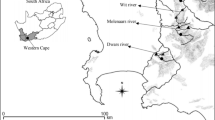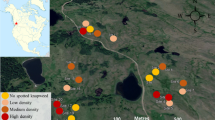Abstract
A frog endemic to Puerto Rico, Eleutherodactylus coqui, invaded Hawaii in the late 1980s, where it can reach densities of 50,000 individuals ha−1. Effects of this introduced insectivore on invertebrate communities and ecosystem processes, such as nutrient cycling, are largely unknown. In two study sites on the Island of Hawaii, we studied the top-down effects of E. coqui on aerial, herbivorous, and leaf litter invertebrates; herbivory, plant growth, and leaf litter decomposition rates; and leaf litter and throughfall chemistry over 6 months. We found that E. coqui reduced all invertebrate communities at one of the two study sites. Across sites, E. coqui lowered herbivory rates, increased NH +4 and P concentrations in throughfall, increased Mg, N, P, and K in decomposing leaf litter, increased new leaf production of Psidium cattleianum, and increased leaf litter decomposition rates of Metrosideros polymorpha. In summary, E. coqui effects on invertebrates differed by site, but E. coqui effects on ecosystem processes were similar across sites. Path analyses suggest that E. coqui increased the number of new P. cattleianum leaves and leaf litter decomposition rates of M. polymorpha by making nutrients more available to plants and microbes rather than through changes in the invertebrate community. Results suggest that E. coqui in Hawaii has the potential to reduce endemic invertebrates and increase nutrient cycling rates, which may confer a competitive advantage to invasive plants in an ecosystem where native species have evolved in nutrient-poor conditions.




Similar content being viewed by others
References
Angulo-Sandoval P, Aide TM (2000) Leaf phenology and leaf damage of saplings in the Luquillo experimental forest, Puerto Rico. Biotropica 32:415–422
Beard KH (2007) Diet of the invasive frog, Eleutherodactylus coqui, in Hawaii. Copeia 2007:281–291
Beard KH, Eschtruth AK, Vogt KA, Vogt DJ, Scatena FN (2003) The effects of the frog Eleutherodactylus coqui on invertebrates and ecosystem processes at two scales in the Luquillo Experimental Forest, Puerto Rico. J Trop Ecol 19:607–617
Beard KH, Pitt WC (2005) Potential consequences of the coqui frog invasion in Hawaii. Divers Distrib 11:427–433
Beard KH, Vogt KA, Kulmatiski A (2002) Top-down effects of a terrestrial frog on nutrient dynamics. Oecologia 133:583–593
Carpenter SR (1999) Microcosm experiments have limited relevance for community and ecosystem ecology: reply. Ecology 80:1085–1088
Chapin FS, Reynolds HL, D’Antonio CM, Eckhart V (1996) The functional role of species in terrestrial ecosystems. In: Walker B, Steffen W (eds) Global change in terrestrial ecosystems. Cambridge University Press, New York
DeWalt SJ, Denslow JS, Ickes K (2004) Natural-enemy release facilitates habitat expansion of the invasive tropical shrub Clidemia hirta. Ecology 85:471–483
Dial R, Roughgarden J (1995) Experimental removal of insectivores from rain forest canopy: direct and indirect effects. Ecology 76:1821–1834
Fritts TH, Rodda GH (1998) The role of introduced species in the degradation of island ecosystems: a case history of Guam. Annu Rev Ecol Syst 29:113–140
Giambelluca TW, Nullet MA, Schroeder TA (1986) Rainfall atlas of Hawaii. Department of Land and Natural Resources, Division of Water and Land Development, Honolulu
Grenyer R, Orme C, Jackson S, Thomas G, Davies R, Davies T, Jones K, Olson V, Ridgely R, Rasmussen P, Ding T, Bennett P, Blackburn T, Gaston K, Gittleman J, Owens I (2006) Global distribution and conservation of rare and threatened vertebrates. Nature 444:93–96
Harmon ME, Lajtha K (1999) Analysis of detritus and organic horizons for mineral and organic constituents. In: Robertson GP, Coleman DC, Bledsoe CS, Sollins P (eds) Standard soil methods for long-term ecological research. Oxford University Press, New York
Hatcher L (1994) A step-by-step approach to using SAS for factor analysis and structural equation modeling. SAS Institute Inc., Cary, NC, USA
Holmes RT, Schultz JC (1988) Food availability for forest birds: effects of prey distribution and abundance on bird foraging. Can J Zool 66:720–728
Hughes RF, Denslow JS (2005) Invasion by a N-2-fixing tree alters function and structure in wet lowland forests of Hawaii. Ecol Appl 15:1615–1628
Juvik SP, Juvik JO (1998) Atlas of Hawaii. University of Hawaii Press, Honolulu
Kraus F (2003) Invasion pathways of terrestrial vertebrates. In: Ruiz GM, Carlton JT (eds) Invasive species: vectors and management strategies. Island Press, Washington, DC
Kraus F, Campbell EW (2002) Human-mediated escalation of a formerly eradicable problem: the invasion of Caribbean frogs in the Hawaiian Islands. Biol Invest 4:327–332
Kraus F, Campbell EW, Allison A, Pratt T (1999) Eleutherodactylus frog introductions to Hawaii. Herpetol Rev 30:21–25
MacNally R (2000) Modeling confinement experiments in community ecology: differential mobility among competitors. Ecol Model 129:65–85
Maron JL, Estes JA, Croll DA, Danner EM, Elmendorf SC, Buckelew SL (2006) An introduced predator alters Aleutian Island plant communities by thwarting nutrient subsidies. Ecol Monogr 76:3–24
Mills HA, Jones JB Jr (1997) Plant analysis handbook II. MicroMacro Publishing, Intl, Athens
Mothershead K, Marquis RJ (2000) Fitness impacts of herbivory through indirect effects on plant-pollinator interactions in Oenothera macrocarpa. Ecology 81:30–40
Nudds TD (1977) Quantifying the vegetative structure of wildlife cover. Wildl Soc B 5:113–117
Ostertag R, Verville JH (2002) Fertilization with nitrogen and phosphorus increases abundance of non-native species in Hawaiian montane forests. Plant Ecol 162:77–90
Parker IM, Simberloff D, Lonsdale WM, Goodell K, Wonham M, Kareiva PM, Williamson MH, Holle BV, Moyle PB, Byers JE, Goldwasser L (1999) Impact: toward a framework for understanding the ecological effects of invaders. Biol Invest 1:3–19
Pitt WC (1999) Effects of multiple vertebrate predators on grasshopper habitat selection: trade-offs due to predation risk, foraging, and thermoregulation. Evol Ecol 13:499–515
Polis GA, Hurd SD (1996) Linking marine and terrestrial food webs: allochthonous input from the ocean supports high secondary productivity on small islands and coastal land communities. Am Nat 147:396–423
Price M, Waser N, Irwin R, Campbell D, Brodya A (2005) Temporal and spatial variation in pollination of a montane herb: a seven-year study. Ecology 86:2106–2116
Schindler DE (1992) Nutrient regeneration by sockeye-salmon (Oncorhynchus nerka) fry and subsequent effects on zooplankton and phytoplankton. Can J Fish Aquat Sci 49:2498–2506
Schmitz OJ (2004) From mesocosms to the field: the role and value of cage experiments in understanding top-down effects in ecosystems. In: Weisser WW, Siemann E (eds) Insects and ecosystem function. Springer, Berlin, Germany
Schmitz OJ, Suttle KB (2001) Effects of top predator species on direct and indirect interactions in a food web. Ecology 82:2072–2081
Schoener TW, Spiller DA (1999) Indirect effects in an experimentally staged invasion by a major predator. Am Nat 153:347–358
Seastedt TR, Tate CM (1981) Decomposition rates and nutrient contents of arthropod remains in forest litter. Ecology 62:13–19
Shurin JB, Gruner DS, Hillebrand H (2006) All wet or dried up? real differences between aquatic and terrestrial food webs. Proc R Soc Lond 273:1–9
Skelly DK (2002) Experimental venue and estimation of interaction strength. Ecology 83:2097–2101
Stewart MM, Woolbright LL (1996) Amphibians. In: Reagan DP, Waide RB (eds) The food web of a tropical rain forest. University of Chicago Press, Chicago
Vanni MJ, Layne CD (1997) Nutrient recycling and herbivory as mechanisms in the “top-down” effect of fish on algae in lakes. Ecology 78:21–40
Vitousek PM (1998) The structure and functioning of montane tropical forests: control by climate, soils, and disturbance. Ecology 79:1–2
Whiles MR, Lips KR, Pringle CM, Kilham SS, Bixby RJ, Brenes R, Connelly S, Colon-Gaud JC, Hunte-Brown M, Huryn AD, Montgomery C, Peterson S (2006) The effects of amphibian population declines on the structure and function of Neotropical stream ecosystems. Front Ecol Environ 4:27–34
Wolfe EW, Morris J (1996) Geologic map of the Island of Hawaii. US Dept. of the Interior, US Geological Survey, Honolulu
Woolbright LL (1985) Patterns of nocturnal movement and calling by the tropical frog Eleutherodactylus coqui. Herpetologica 41:1–9
Woolbright LL, Hara AH, Jacobsen CM, Mautz WJ, Benevides FL (2006) Population densities of the Coqui, Eleutherodactylus coqui (Anura: Leptodactylidae) in newly invaded Hawaii and in native Puerto Rico. J Herpetol 40:122–126
Acknowledgments
We thank Kamehameha Schools and Hawaii's Division of Forestry and Wildlife for allowing access to work on their lands. This research was supported by USDA/APHIS/WS/NWRC, Jack Berryman Institute at Utah State University, US Fish and Wildlife Service, and Hawaii Department of Natural Resources (Hawaii Invasive Species Council). We thank S. Durham and G. P. Kyle for statistical advice and R. McGuire, L. Hamilton, and D. Grant for field and laboratory assistance.
Author information
Authors and Affiliations
Corresponding author
Rights and permissions
About this article
Cite this article
Sin, H., Beard, K.H. & Pitt, W.C. An invasive frog, Eleutherodactylus coqui, increases new leaf production and leaf litter decomposition rates through nutrient cycling in Hawaii. Biol Invasions 10, 335–345 (2008). https://doi.org/10.1007/s10530-007-9133-x
Received:
Accepted:
Published:
Issue Date:
DOI: https://doi.org/10.1007/s10530-007-9133-x




